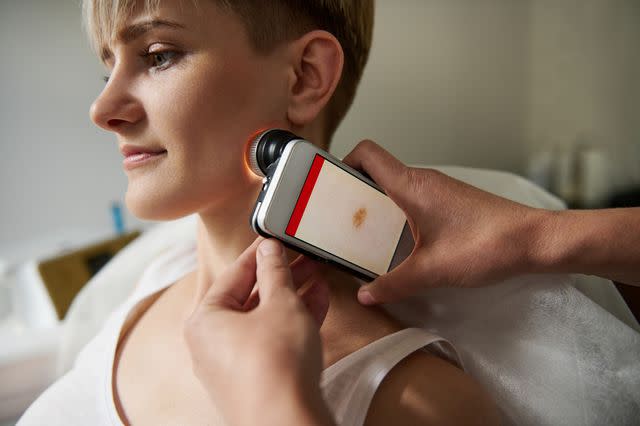Dysplastic Nevus: When Atypical Moles Are Precancerous
Medically reviewed by Steffini Stalos, DO
A dysplastic nevus is an atypical mole. It may have some abnormal features in terms of size, color, shape, and texture but is not considered cancerous. Nevus (plural: nevi) is the clinical term for a skin mole.
A mole (nevus) is a benign and common skin growth produced by melanocytes (cells that secrete skin pigment). Melanocytes can become abnormal and produce a dysplastic nevus. Melanoma, a type of aggressive skin cancer, also results from abnormal melanocytes that have become cancerous.
This article will discuss what a dysplastic nevus is, what it looks like, how it’s diagnosed, the risk that it will develop into melanoma, and how to treat it.

Taras Grebinets / Getty Images
Dysplastic Nevus on Pathology: Is It Cancer?
A dysplastic nevus has distinct features, which are visible when a pathologist examines its cells under a microscope. The cells don’t look completely normal. They may display some features that look like early-stage melanoma. However, these cells don’t have the features that make them cancerous.
It's rare for a dysplastic nevus to become cancerous. But it can pose a higher risk of developing into melanoma compared to an ordinary mole. Monitoring these moles for progression to melanomas is crucial. Most melanomas don't develop from a dysplastic nevus.
Characteristics of Dysplastic Nevus
Dysplastic nevi typically have several characteristics that make them appear different from a regular mole.
Irregular border: The border is often uneven, blending into the surrounding skin, differing from a regular mole, which has a well-defined, smooth edge.
Asymmetry: One half of the mole doesn’t mirror the other and appears asymmetrical. Regular moles are symmetrical.
Varied color: The mole may show various colors, which can include brown, tan, red, and black. Regular moles are usually the same color throughout.
Larger size: A dysplastic nevus tends to be larger than a regular mole, sometimes bigger than 5 millimeters (one-fifth of an inch) in diameter.
Surface changes: The surface of the dysplastic nevus may be raised or flat and may vary throughout the mole. A regular mole’s surface is often flat and even throughout.
Treatment for Dysplastic Nevus
Generally, a dysplastic nevus doesn’t require any specific treatment. It usually involves regular self-monitoring for changes and routine evaluation by a dermatologist (a skin condition specialist).
If a dysplastic nevus shows concerning changes or looks like it has changed into melanoma, the dermatologist may decide to biopsy it (remove it to analyze in the laboratory). Removing the nevus in a biopsy is both diagnostic (to see if it's cancerous or not) as well as a treatment if it is.
When the biopsy is complete, the dermatologist may recommend further treatment or more frequent monitoring if it shows any abnormality or high-risk feature. If it's cancerous, further surgery or other treatments may prove necessary.
Risks of Unmonitored Dysplastic Nevus
An untreated or unmonitored dysplastic nevus can come with risks, even if the mole isn't cancerous. Some of these risks include:
Increased risk of melanoma
Difficulty detecting concerning changes
A missed opportunity for early detection and treatment of melanoma
Why Do Some People Develop Dysplastic Nevus?
Various factors can cause the development of dysplastic nevi. Some of these contributing factors can include:
Certain genetic changes
A history of sun exposure and other ultraviolet light exposure
Having fair skin and light hair and eyes
Immune suppression
A family history of skin cancer
Those who have dysplastic nevi face a slightly increased risk of developing melanoma compared to someone who doesn't have an atypical mole. However, not everyone with dysplastic nevi will develop melanoma.
Where to Get an Atypical Mole Examined
The first place to start is to examine an atypical mole yourself. Perform regular skin checks to look for any changes so you know what is normal for you. A regular skin check for any changes in moles or new lesions can help detect skin cancer early.
If you notice anything concerning, you can seek a further evaluation with your healthcare provider, who may be your:
Primary care provider: A healthcare provider can examine your skin for anything atypical. They may even elect to perform a biopsy. However, they may refer you to a dermatologist for a more specialized evaluation.
Dermatologist: This provider specializes in skin conditions and is well-educated on atypical moles. In addition to a skin examination, they may offer a biopsy and suggestions or recommendations for how best to manage a concerning skin lesion.
Telehealth dermatology care: Some providers may offer a virtual consultation during which pictures of the mole can be submitted for your dermatologist's evaluation. Though this is convenient, it can’t replace an in-person healthcare professional's skin examination.
Diagnosing a Dysplastic Nevus
A healthcare provider will examine the mole and surrounding skin to evaluate its size, shape, color, and any irregularities. They may perform a dermoscopy using a handheld device to get a magnified look at the mole. If suspicious, they may perform a biopsy to remove the mole to send to the lab for a cancer evaluation
Can Dysplastic Nevus Grow Back After Removal?
After removal, a dysplastic nevus typically doesn't grow back unless its removal is incomplete. However, new moles can develop in different areas of the skin. Continuing routine skin examinations to evaluate any new mole growth or changes is crucial.
Summary
A dysplastic nevus is a mole that isn't cancerous but does carry an increased risk of becoming cancerous. Its shape, size, color, or texture characteristics can differ from those of the common mole. Performing regular skin self-examinations to look for the presence of anything abnormal is important. If you have concerns, contact a healthcare provider.
Although a dysplastic nevus might not require removal, your healthcare professional should follow it closely for any changes.
Read the original article on Verywell Health.

